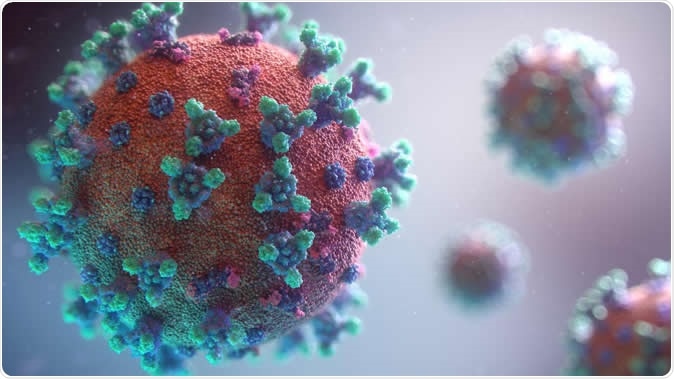Surfaces coated with a quaternary ammonium polymer have remarkable antiviral properties. They may even be capable of reducing the spread of severe acute respiratory syndrome coronavirus 2 (SARS-CoV-2) in areas with high risk for contamination, such as indoor environments or public places. University of Arizona researchers explain the antiviral potential of these in a new study published on the preprint server medRxiv*.

Image Credit: Fusion Medical Animation
Several months into the coronavirus disease (COVID-19) pandemic that has already claimed a large number of human lives and devastated economies worldwide, researchers still lack a complete understanding of the SARS-CoV-2 transmission process. We already know that the virus is primarily spread by droplets after coughing, sneezing, or even talking – all within a few feet range.
The European Centre for Disease Prevention and Control (ECDC) reported that the environmental stability of SARS-CoV-2 is up to three hours in the air after dispersal, four hours on copper, 24 hours on cardboard, and up to 2–3 days on stainless steel and plastic.
Inanimate surfaces that harbor both respiratory and enteric human viral pathogens are known as fomites. Levels of infectious viruses can be reduced by surface disinfection, consequently lowering their spreading potential in commercial, health care, and residential environments.
Alas, these surfaces can become recontaminated at any time after the usage of common liquid disinfectants that are generally wiped dry from surfaces. In recent years, many self-disinfecting surfaces with the ability to inactivate deposited pathogens have emerged. The main advantage of specific antiviral coating is rendering viruses non-infective in contact with a treated surface.
A research group from the Center for Water, Environment and Sustainable Technology at the University of Arizona in Tuscon, US, previously reported the use of a novel continuously active antimicrobial coating shown to reduce the spread of hospital-acquired infections in the clinical arena.
The second generation of this technology, designed to provide additional antiviral action, was recently developed. Hence, a new research endeavor by the same group looked to appraise the efficacy of this technology against a common cold coronavirus (human coronavirus 229E or HCoV-229E) so as to extrapolate the findings against SARS-CoV-2.
Appraising the antiviral coating performance
A strain of HCoV-229E was propagated and assayed in the human lung fibroblast MRC-5 cell line (which is commonly used in virology research, cytotoxicity testing, and even vaccine development), and then diluted to achieve the desired inoculum. The virus was then inoculated and dried onto control and treated carriers for testing purposes.
The American Society of Testing and Materials (ASTM) method was utilized to assess the antiviral coating performance. This quantitative technique is often used to evaluate the efficacy of sanitizers on pre-cleaned nonporous and non-food inanimate surfaces.
Finally, the efficacy of the test substance was determined by calculating the logarithmic reduction of infectious viral particles remaining after test product exposure during the 10-minute contact time, relative to the infectious viral titer in the control suspension.
The additional layer of protection
After conducting the experiments, the efficacy results were staggering; a reduction of more than 90% in the number of viral particles has been observed after ten minutes when compared to the untreated control surface and more than 99.99% within two hours.
Furthermore, when tested in suspension, the coating formulation yielded a greater than 99.99% reduction of HCoV-229E within only ten minutes of contact – showing remarkable residual efficacy against coronavirus.
This outcome presents a perfect opportunity for adequate control of COVID-19 transmission from contaminated fomites. However, this does not mean that regular procedures for high-touch surfaces should be completely neglected.
"Antimicrobial-coated surfaces are not meant to substitute for regular cleaning and disinfection of surfaces, but rather offer an additional barrier to reduce human exposure to infectious viruses from fomites," emphasize study authors.
High-touch fomites as an exposure route
During the fall season, pathogenic respiratory viruses (such as influenza and parainfluenza) can be found on at least one-third of common high-touch fomites, which therefore serve as an exposure route for the transmission of a wide array of infectious agents.
"It has been found that the contamination of a push plate door entrance into an office building can lead to contamination of 50% of the commonly touched surfaces and hands of office workers within four hours", emphasize study authors. "Interventions that employ disinfecting wipes have been shown to reduce the probability of infection in office settings," they add.
In any case, antimicrobial coatings could provide an additional layer of protection in hampering the spread of coronaviruses both indoors and in public places, where continuous contamination can be expected. They could actually prove to be an additional weapon in our armamentarium against COVID-19.

 This news article was a review of a preliminary scientific report that had not undergone peer-review at the time of publication. Since its initial publication, the scientific report has now been peer reviewed and accepted for publication in a Scientific Journal. Links to the preliminary and peer-reviewed reports are available in the Sources section at the bottom of this article. View Sources
This news article was a review of a preliminary scientific report that had not undergone peer-review at the time of publication. Since its initial publication, the scientific report has now been peer reviewed and accepted for publication in a Scientific Journal. Links to the preliminary and peer-reviewed reports are available in the Sources section at the bottom of this article. View Sources
Sources:
Journal references: